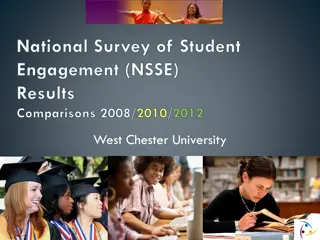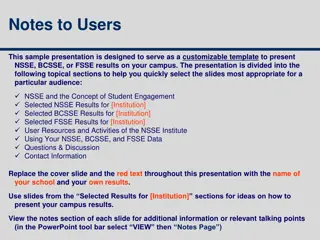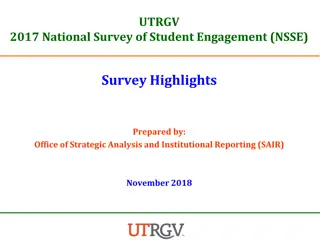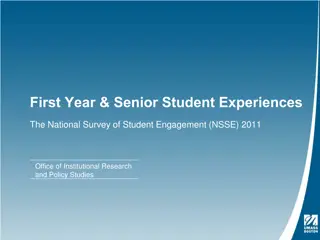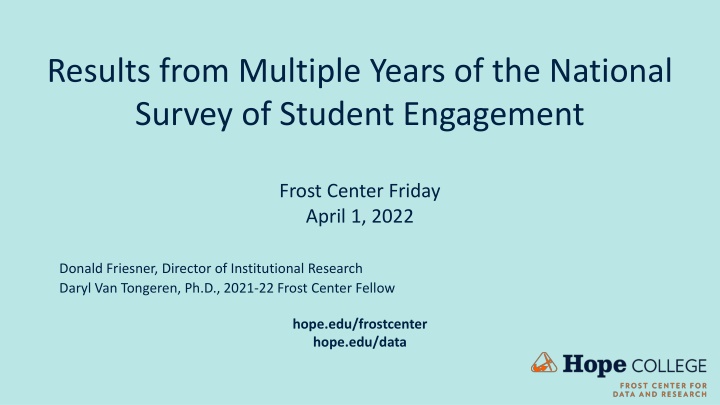
Insights from National Survey of Student Engagement Analysis
Explore trends in student engagement based on the National Survey of Student Engagement (NSSE) data from 2013 to 2020, focusing on academic challenge, learning with peers, experiences with faculty, and campus environment. Discover key findings and patterns in first-year and senior student responses, along with comparisons across institutions and engagement indicators.
Download Presentation

Please find below an Image/Link to download the presentation.
The content on the website is provided AS IS for your information and personal use only. It may not be sold, licensed, or shared on other websites without obtaining consent from the author. If you encounter any issues during the download, it is possible that the publisher has removed the file from their server.
You are allowed to download the files provided on this website for personal or commercial use, subject to the condition that they are used lawfully. All files are the property of their respective owners.
The content on the website is provided AS IS for your information and personal use only. It may not be sold, licensed, or shared on other websites without obtaining consent from the author.
E N D
Presentation Transcript
Results from Multiple Years of the National Survey of Student Engagement Frost Center Friday April 1, 2022 Donald Friesner, Director of Institutional Research Daryl Van Tongeren, Ph.D., 2021-22 Frost Center Fellow hope.edu/frostcenter hope.edu/data
Todays Agenda Overview of the NSSE Survey* Patterns in First-Year and Senior Hope students responses from 2013 through 2020 Patterns from the Inclusiveness and Engagement with Diversity Topical Module, 2019 and 2020 Discussion, conversation, questions * Indiana University School of Education, Center for Post-Secondary Research National Survey of Student Engagement (NSSE)
The NSSE Survey Provides data on First-Year and Senior College Students Compares institutions on 10 Engagement Indicators 6 High Impact Practices Administered each Spring semester since 2000 In 2020, 601 Colleges and Universities Participated 484,282 student responses in 2020 About 6 millions student have participated since 2000 2020 Hope Administration of NSSE First-Year Students: n=335; 46% response rate Senior Students: n=305; 44% response rate
NSSE Engagement Indicators Within 4 Themes Theme: Academic Challenge Higher-Order Learning Reflective and Integrative Learning Learning Strategies Quantitative Reasoning Theme: Learning with Peers Collaborative Learning Discussions with Diverse Others
NSSE Engagement Indicators Within 4 Themes Theme: Experiences With Faculty Student-Faculty Interaction Effective Teaching Practices Theme: Campus Environment Quality of Interactions Supportive Environment
Academic Challenge Academic Challenge: First-year students Higher-Order Learning Reflective & Integrative Learning Learning Strategies Quantitative Reasoning 60 60 60 60 41.6 45 45 45 45 40.239.338.739.6 40.0 40.0 40.139.5 39.8 40.038.739.5 38.2 37.7 37.0 37.6 37.5 36.935.9 35.836.4 36.0 35.9 29.228.0 27.928.629.8 27.927.027.7 30 30 30 30 15 15 15 15 Key Findings: -Hope scores of Higher-Order Learning are trending downwards from 2013 to 2020, for both First-Year and Senior 0 0 0 0 2013 2014 2015 2016 2017 2018 2019 2020 2013 2014 2015 2016 2017 2018 2019 2020 2013 2014 2015 2016 2017 2018 2019 2020 2013 2014 2015 2016 2017 2018 2019 2020 Academic Challenge: Seniors Higher-Order Learning Reflective & Integrative Learning Learning Strategies Quantitative Reasoning 60 60 60 60 42.5 41.540.939.939.1 39.039.8 40.6 41.2 41.040.3 40.840.0 39.4 45 45 45 45 39.238.2 39.7 38.9 36.6 36.737.737.0 38.1 36.6 31.129.9 29.6 29.230.0 30.1 29.8 27.6 30 30 30 30 15 15 15 15 0 0 0 0 2013 2014 2015 2016 2017 2018 2019 2020 2013 2014 2015 2016 2017 2018 2019 2020 2013 2014 2015 2016 2017 2018 2019 2020 2013 2014 2015 2016 2017 2018 2019 2020
Learning With Peers Learning with Peers: First-year students Collaborative Learning Discussions with Diverse Others 60 60 45 45 40.039.1 38.7 38.3 37.8 36.9 36.9 36.5 37.0 35.936.6 36.5 36.2 35.6 34.3 33.5 30 30 15 15 Key Findings: -Hope scores for both groups have generally held steady 0 0 2013 2014 2015 2016 2017 2018 2019 2020 2013 2014 2015 2016 2017 2018 2019 2020 Learning with Peers: Seniors Collaborative Learning -Hope Senior scores for Discussions with Diverse Others decreased from 2018 to 2020 Discussions with Diverse Others 60 60 45 45 38.5 35.5 36.3 36.137.0 37.4 36.8 36.735.6 36.2 36.6 36.635.7 35.3 34.6 34.7 30 30 15 15 0 0 2013 2014 2015 2016 2017 2018 2019 2020 2013 2014 2015 2016 2017 2018 2019 2020
Experiences with Faculty: First-year students Student-Faculty Interaction Experiences With Faculty Effective Teaching Practices 60 60 42.7 42.040.839.6 39.7 45 45 40.239.240.2 30 30 25.5 24.5 24.1 24.3 24.0 22.6 22.5 22.2 15 15 Key Findings: -First-Year students report a lower overall score on Student-Faculty Interaction than Senior students. 0 0 2013 2014 2015 2016 2017 2018 2019 2020 2013 2014 2015 2016 2017 2018 2019 2020 Experiences with Faculty: Seniors Student-Faculty Interaction Effective Teaching Practices 60 60 -Of all measures in NSSE, Student-Faculty Interaction with First-Year students score the lowest, with scores regularly below 30. 44.5 43.1 42.7 43.0 42.6 41.9 41.6 45 45 40.5 33.0 31.631.0 30.6 30.730.0 30.6 29.2 30 30 15 15 -Scores for Effective Teaching Practices have generally held steady for both groups. 0 0 2013 2014 2015 2016 2017 2018 2019 2020 2013 2014 2015 2016 2017 2018 2019 2020
Campus Environment: First-year students Quality of Interactions Supportive Environment Campus Environment 60 60 48.447.446.146.8 46.447.246.4 46.0 42.6 40.9 40.7 40.541.2 45 45 40.7 37.9 37.5 30 30 15 15 Key Findings: -Quality of Interactions have generally held steady with both groups. 0 0 2013 2014 2015 2016 2017 2018 2019 2020 2013 2014 2015 2016 2017 2018 2019 2020 Campus Environment: Seniors Quality of Interactions Supportive Environment -Hope students in both groups have seen a decrease in scores related to Supportive Environment, since 2017. 60 60 46.0 45.9 45.8 46.2 45.9 45.844.946.0 45 45 38.6 38.3 37.8 37.536.7 34.8 35.0 34.9 30 30 15 15 0 0 2013 2014 2015 2016 2017 2018 2019 2020 2013 2014 2015 2016 2017 2018 2019 2020
2020 Comparisons to NSSE Top 50% First-Year Students NSSE Top 50% 39.3* 36.7 39.9*** 29.4* Theme Engagement Indicator Higher-Order Learning Reflective and Integrative Learning Learning Stratgies Quantitative Reasoning Hope Mean 37.7 36.0 37.0 27.7 Key Findings: -Hope mean scores for First- Year Students are statistically lower in Higher-Order Learning Learning Strategies Quantitative Reasoning Discussions with Diverse Others Student-Faculty Interaction Academic Challenge Learning with Peers Collaborative Learning Discussions with Diverse Others 34.3 38.3 35.2 41.5*** Experiences with Faculty Student-Faculty Interaction Effective Teaching Practices 22.6 40.2 24.5* 40.5 Campus Environment Quality of Interactions Supportive Environment 46.8 37.5 45.2* 37.9 - Hope mean scores for First- Year Students are statistically higher in Quality of Interactions Green indicates a higher Hope score than the NSSE Top 50%
2020 Comparisons to NSSE Top 50% Senior Students NSSE Top 50% 41.7** 39.8 40.7*** 31.4 Theme Engagement Indicator Higher-Order Learning Reflective and Integrative Learning Learning Stratgies Quantitative Reasoning Hope Mean 39.4 39.7 37.0 30.1 Key Findings: -Hope mean scores for Senior Students are statistically lower in Higher-Order Learning Learning Strategies Discussions with Diverse Others Academic Challenge Learning with Peers Collaborative Learning Discussions with Diverse Others 36.8 34.7 35.9 42.1*** Experiences with Faculty Student-Faculty Interaction Effective Teaching Practices 30.6 41.6 29.7 41.8 Campus Environment Quality of Interactions Supportive Environment 46.0 34.9 45.2 34.6
Inclusiveness and Engagement with Diversity First-Year Students Hope Overall Hope Overall 1 Very little 28 10 3,046 6 Demonstrating a commitment to diversity How much does you institution emphasis the following? 2 Some 92 36 13,456 25 3 Quite a bit 90 35 22,328 41 2.6 2.9 *** 4 Very much 47 19 16,189 29 Total 257 100 55,019 100 1 Very little 26 9 3,525 7 Providing students with the resources needed for success in a multicultural world 2 Some 81 32 15,092 28 3 Quite a bit 103 40 22,233 40 2.7 2.8 ** 4 Very much 48 20 14,109 25 Key Finding -Hope students report lower levels of engagement scores than the overall mean scores of other institutions in 2020 Total 258 100 54,959 100 Seniors Hope 39 Overall Hope Overall a.Demonstrating a commitment to diversity 1 Very little 15 4,420 7 2 Some 125 47 15,749 24 3 Quite a bit 70 28 24,340 38 2.3 2.9 *** 4 Very much 26 10 20,053 31 Total 260 100 64,562 100 b.Providing students with the resources needed for success in a multicultural world 1 Very little 44 17 5,550 9 2 Some 125 47 19,135 30 3 Quite a bit 66 27 23,528 36 2.3 2.8 *** 4 Very much 23 9 16,303 25 Total 258 100 64,516 100
Inclusiveness and Engagement with Diversity First-Year Students Hope Overall Hope Overall 1 Very little 12 4 2,767 5 Creating an overall sense of community among students How much does you institution emphasis the following? 2 Some 45 15 12,350 23 3 Quite a bit 104 42 22,842 41 3.1 3.0 ** 4 Very much 97 38 16,996 30 Total 258 100 54,955 100 1 Very little 12 5 2,807 5 Taking allegations of discrimination or harassment seriously 2 Some 47 18 11,144 20 3 Quite a bit 108 41 21,842 40 3.1 3.0 Key Finding -Hope First-year students report higher scores than the mean for other institutions in creating a sense of community in 2020 4 Very much 90 36 19,067 35 Total 257 100 54,860 100 Seniors Hope Overall Hope Overall 1 Very little 18 6 4,984 8 Creating an overall sense of community among students 2 Some 74 28 16,672 26 3 Quite a bit 106 42 24,603 38 2.8 2.9 4 Very much 60 24 18,247 28 Total 258 100 64,506 100 1 Very little 26 10 5,735 9 Taking allegations of discrimination or harassment seriously 2 Some 58 22 15,050 23 3 Quite a bit 119 46 23,135 36 2.8 2.9 *** 4 Very much 54 22 20,425 32 Total 257 100 64,345 100
Key observations The Higher-Order Learning scores for Hope are trending downwards from 2013 to 2020, for both First-Year and Senior Students. Hope Senior scores for Discussions with Diverse Others decreased from 2018 to 2020. Student-Faculty Interaction with First-Year students score the lowest, with scores regularly below 30. Hope students in both groups have seen a decrease in scores related to Supportive Environment since 2017.
Key observations Hope students report lower scores than their peers regarding the institutions emphasis on: Demonstrating a commitment to diversity Providing students with the resources necessary to be successful in navigating a multicultural world NSSE Surveys can assist Hope College in understanding how students spend their time and what they gain from attending college.
Discussion, conversation, questions Who at Hope College (positions or departments) would benefit from the information shared today? Thinking about your own work at Hope, how might you use what you ve learned today? How might data from this survey continuously inform decisions to benefit Hope students?




